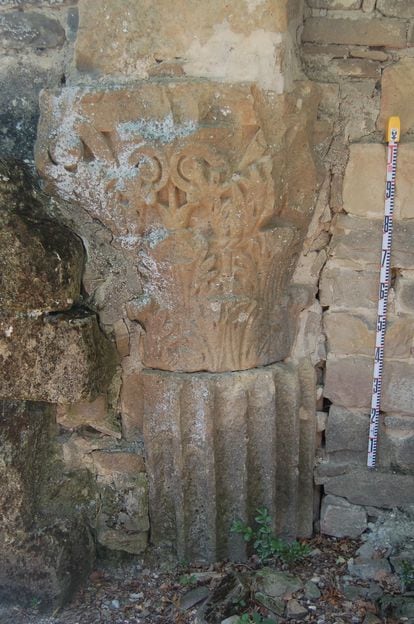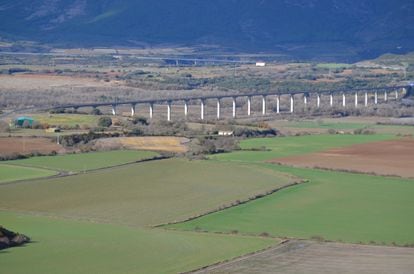In 2018, the Metropolis Council of Artieda—situated in northeastern Spain within the province of Zaragoza, and a part of the nation’s Aragon area—requested the College of Zaragoza’s Archaeology Division for assist in learning some ruins situated across the San Pedro hermitage, recognized variously as El Forau de la Tuta, Campo de la Virgen, or Campo del Royo. Three years later, the consultants have confirmed that these websites shaped a big single archaeological complicated, and so they detected two phases of occupation on the floor of the positioning: one in the course of the imperial Roman interval (the first to fifth centuries) and one other in the course of the early-medieval Christian period (the ninth to thirteenth centuries). Now, the analysis group has revealed the ends in a report, El Forau de la Tuta: A Hitherto Unknown Roman Imperial Metropolis on the Southern Slopes of the Pyrenees. It’s putting that, regardless of the town’s massive dimensions and “buildings of monumental proportions,” nobody is aware of its historical title.
The research was authored by the consultants José Ángel Asensio, Paula Uribe, Lara Íñiguez, María Ángeles Magallón, Milagros Navarro, Jorge Angás, Enrique Ariño, Irene Mañas, Carmen Guiral, Cristian Concha, Óscar Lanzas, Aurora Asín, and Guillermo Mora. The report notes that based mostly on vital proof from the ruins preserved within the hermitage, in addition to artifacts held in numerous private and non-private collections and the findings on the web site, the settlement was “of city character—the town’s title is at the moment unknown—and it developed in the course of the [Roman] imperial interval. Later, the identical web site took on one other iteration as a rural habitat in the course of the Visigoth and early Andalusian intervals.”
The specialists have additionally discovered that, between the ninth and thirteenth centuries, one other peasant habitat-type city or village was superimposed on high of the Roman settlement. They’ve recognized the village as Artede, Arteda, Artieda or Arteda Ciuitate. The medieval enclave’s ruins embody the chief of the church’s stays, embedded within the San Pedro hermitage; quite a few silos with round openings, which had been excavated from the subsoil and solely perceptible by geo-radar; and an in depth cemetery per Christian burial rites (the Paleoymás firm partially investigated the latter in 2020).

The El Forau de la Tuta web site is situated 1.5 kilometers from Artieda’s metropolis heart, on the fertile plain of the Aragón River. It’s located inside an agricultural plot about 390 meters lengthy and 140 meters large. It occupies an space of 4 hectares, however it’s doable that the positioning’s dimensions are even bigger and that it extends to different—nonetheless unexplored—agricultural lands.
The French Route
The Roman settlement stood subsequent to the street connecting three northern cities: Iaca (Jaca, Huesca), Ilumberri (Lumbier, Navarra) and Pompelo (Pamplona, Navarra). At present referred to as Camino Actual de Ruesta a Mianos (the Excessive Street from Ruesta to Mianos), the street lasted by the Center Ages as a stretch of the French Route, the Arles Manner or the Through Tolosana (Tolouse Route), as a part of the Manner of St. James (Camino de Santiago), which ends up in France.
Contained in the hermitage, the research’s authors have recognized two Corinthian capitals, three Italic Attic bases, a classical Attic base, a number of flat-edged fluted shaft drums, and a fraction of cornice. The large dimensions and typology of the artifacts point out that they got here from a number of early imperial public buildings. In line with José Ángel Asensio, one of many investigation’s analysis administrators, two of the capitals “would have been a part of Corinthian columns greater than six meters excessive, and they’d have belonged to a public constructing of monumental dimensions, maybe a discussion board temple. Relating to their chronology, stylistically they are often dated to the tip of the primary century, from the late Flavian interval or the start of the Antonine interval.”
The research confirms that these items come from no less than two completely different monuments. Their typologies point out that they had been sculpted greater than half a century aside, “which demonstrates a protracted interval within the means of monumentalizing the town.”
To the west of El Forau de la Tuta, subsequent to the San Pedro ravine, “a powerful set of public works made from opus caementicium, together with no less than 4 sewer shops, a robust huge abutment, a basis, and a collection of quadrangular constructions,” probably provide cisterns, can also be preserved. The sewers are coated with barrel vaults and formwork which might be supported by 0.80-meter-high facet partitions. “The presence of those works is typical of city settlements, the place water drainage was an issue that needed to be addressed, particularly in relation to buildings, resembling bathtub homes, that produced a considerable amount of water waste.
This report by consultants from the Instituto de Estudios Altoaragoneses [Institute for Early Aragon Studies], the colleges of Zaragoza, Bordeaux, Madrid Polytechnic, Salamanca, UNED [National University of Distance Education] , and the Zaragoza Faculty of Tourism additionally signifies the situation of 4 tombstones from the positioning, which had been held in Jaca’s Diocesan Museum and in non-public collections in Artieda. Analyzing their inscriptions, the archaeologists have concluded that the gravestones got here from an “vital cemetery that was maintained by the tip of the interval.” As well as, a number of the names engraved on the tombstones are of Basque-Aquitaine origin, “which helps the presumed Basque ethno-linguistic affiliation of the inhabitants of this a part of the Jacetania-Canal de Berdún area throughout Roman occasions.”

Archaeologists are additionally at the moment learning a sculptural fragment that’s preserved in an Artieda non-public assortment. The artifact—which was collected close to the hermitage–is an incomplete, practically life-sized left hand that holds a patera umbilicata [an offering bowl], which might have been a part of a statue representing an providing determine. The limb was sculpted in white Luni (Carrara) marble, a cloth usually utilized in early-imperial city settlements.
Within the first spherical of excavations in 2021, the archaeologists confirmed the existence of an intersection of two roads. “On one of many roads, probably one of many settlement’s primary streets, we documented the ruins of a sidewalk and a floor channel for draining water, which pedestrians may circumvent by way of three steppingstones. Judging by the presence of the 2 sq. foundations on its sides, this primary avenue will need to have had a porticoed sidewalk,” explains Asensio.
A Constructing for Baths
Equally, in one of many excavations they carried out, the archaeologists discovered ample stays of black and white mosaics (tesserae and fragments of rudus), in addition to pavement within the subsoil that belonged “to an oblong area of about 5 by 3.50 meters, which preserved the entryway’s threshold, which was carved into two items of sandstone and housed a double swing door.” The consultants affiliate this discovering with a constructing for baths.
Inside this construction, below numerous slabs that fell within the constructing’s collapse, archaeologists discovered a virtually full black and white tessellated pavement (with some remoted purple and yellow tesserae); it was terribly preserved. Adorned with iconographic motifs in white on a black background, it has shells or scallops within the 4 corners, whereas the central emblem options seahorses, ridden by little Cupids, dealing with one another subsequent to 3 representations of marine animals, a fish within the higher half and probably two dolphins within the decrease half.
Thus, the archaeologists are sure that the whole lot they’ve discovered up to now “corresponds to a single city complicated from between the primary and second centuries, and that the town had infrastructure and public monuments, together with baths, a water provide system, common city planning, sewers, and probably a temple. They admit to being shocked at not understanding the town’s title, however no historic doc mentioning it has survived.